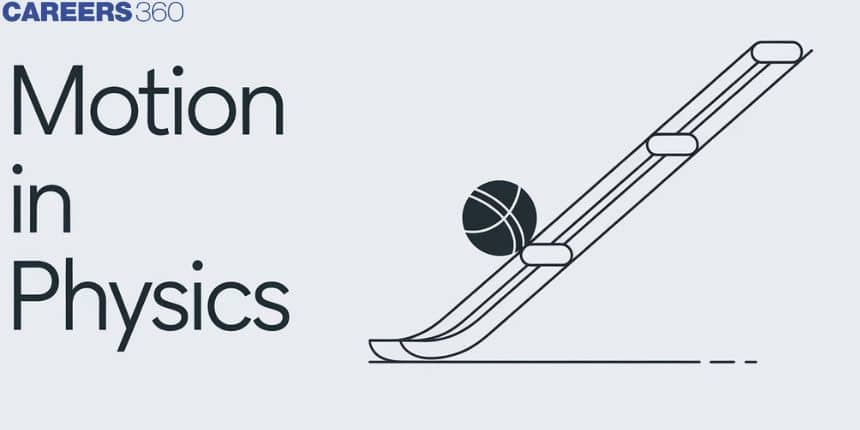Motion in Physics - Definition, FAQs
What is motion in Physics?
Motion definition physics: Motion in physics, movement is a phenomenon in which an object over time changes position. In terms of movement, distance, speed, acceleration and time, motion is described quantitatively.

Three laws of motion
The movement of huge bodies is described in physics by two related sets of mechanical rules. Classical mechanics describe motion in the Universe for all huge as well as recognisable items
The three rules of classical mechanics were formulated by Newton as well as Euler historically:
The three equations of motion are as follows:
1.
2.
3.
Also read -
- NCERT Solutions for Class 11 Physics
- NCERT Solutions for Class 12 Physics
- NCERT Solutions for All Subjects
Newton's 1st law of motion or law of inertia.
"Everything continues to be in its state of rest or uniform motion along a straight line unless driven to act otherwise by some other body," Newton's first law states. The property of a body that resists changes in its state of rest or uniform motion is known as inertia. If the total external force is zero, an object in uniform motion will remain in uniform motion, and an object at rest will remain at rest.
Newton's second law of motion
The vector sum of the forces F on an object in an inertial reference frame equals the object's mass m multiplied by its acceleration.
F=ma
It is a vector quantity
SI Unit Newton (N)
Newton's third law of motion
When one body puts a force on another, the second body simultaneously exerts a force on the first body that is equal in size and opposite in direction.
Action = -reaction
|
Related Topics Link, |
Translational motion
The driving force F is balanced in translational motion by a resisting force Fr generated by the driven machine and an inertia force Ma generated by the change in speed, or
F-Fr=Ma=Mdv/dt
Where M is the mass given in kilogrammes the velocity v in metres per second, the acceleration an in metres per second2, and the force F in Newton (N)
Oscillatory motion
Periodic or oscillatory motion is defined as a motion that repeats itself. Due to a restoring force or torque, an object in such motion oscillates around an equilibrium position. No matter which direction the system is moved, such force or torque tends to restore (return) the system to its equilibrium position.
NCERT Physics Notes:
Rotational motion
In rotational motion, the driving torque Tm (often generated by an electric motor) is balanced by a resisting torque TL (typically generated by the load and referred to as the motor shaft) and inertia or dynamic torque Jdω/dt.
Where
Torque or moment, where
With
Relativistic mechanics
Modern kinematics evolved from the study of electromagnetic and refers to all velocities v in terms of their ratio to the speed of light c. Velocity is thus understood as rapidity, the hyperbolic angle for which the hyperbolic tangent function tan h = v/c. Acceleration, or a change in velocity, affects rapidity according to Lorentz transformations. This branch of mechanics is known as special relativity. W. K. Clifford and Albert Einstein both attempted to incorporate gravity into relativistic mechanics. The development employed differential geometry to describe a curved cosmos with gravity; the research is known as general relativity.
Also, check-
Frequently Asked Questions (FAQs)
The fundamental equation of motion in classical mechanics is Newton's second law, which states force F acting on body is equal to mass of an object multiplied by acceleration (a), F = ma.
When an object moves in a straight line at constant speed, it is said to be moving with uniform motion. When a car travels at a steady speed, resistive forces such as air resistance as well as frictional forces in automobile's moving parts balance the engine's driving power.
Uniform Motion | Non-uniform Motion |
An object covers equal distance in equal interval of time then object is said to have uniform motion. | When an object travels an unequal distance in an equal amount of time, it is said to be moving in a non-uniform manner/motion . |
Steady speed or velocity | Variable speed or velocity |
Graph plotting between distance along with time is always a straight line. | Graph plotting between distance along with time is Not a straight line. |
Acceleration is Zero. | Acceleration is non-zero. |
Also Read
22 Jun'25 04:12 PM
05 Feb'25 04:57 PM
11 Jan'25 03:00 PM
24 Dec'24 01:28 PM
27 Nov'24 01:02 PM
26 Nov'24 01:31 PM
20 Nov'24 04:50 PM
20 Nov'24 12:59 PM
16 Nov'24 01:06 PM
14 Nov'24 04:17 PM

